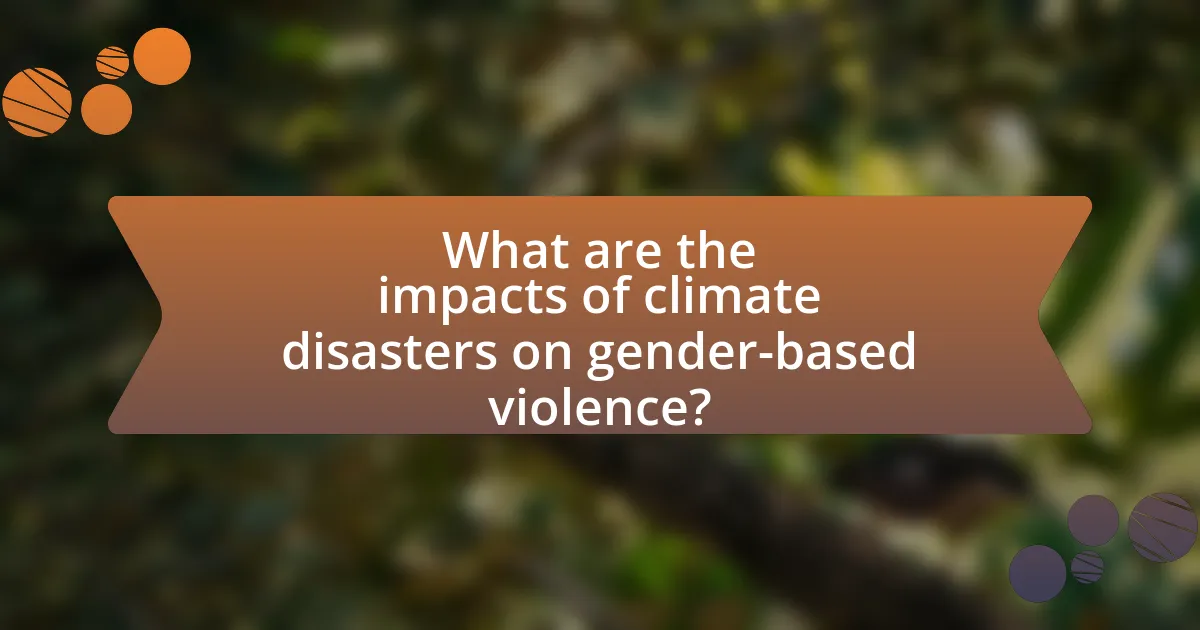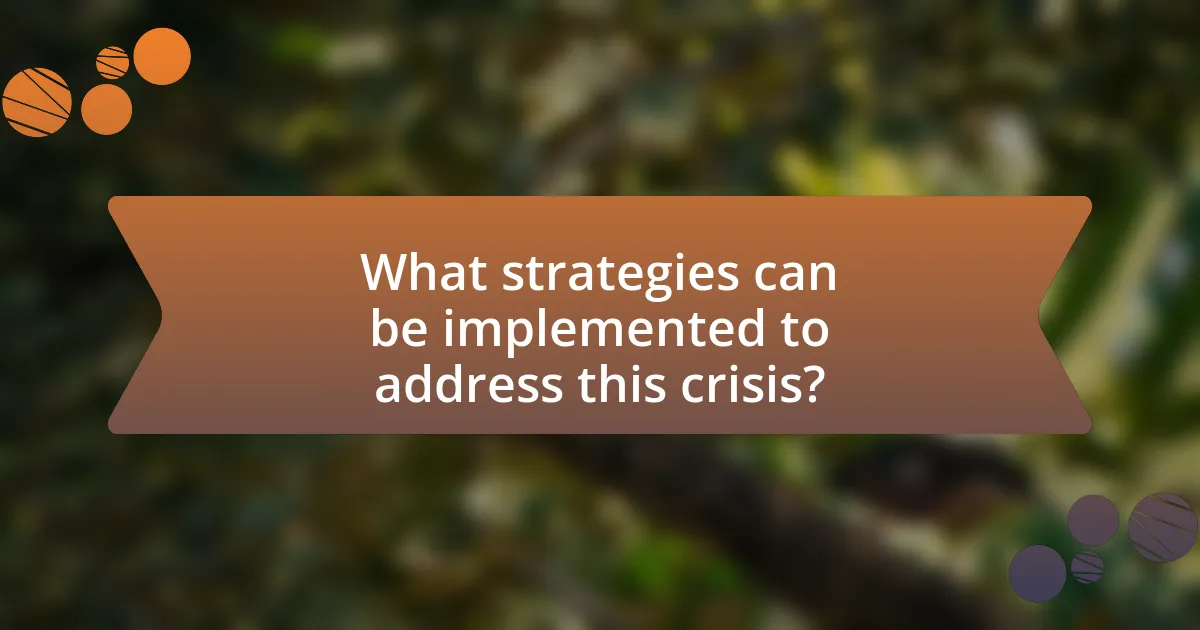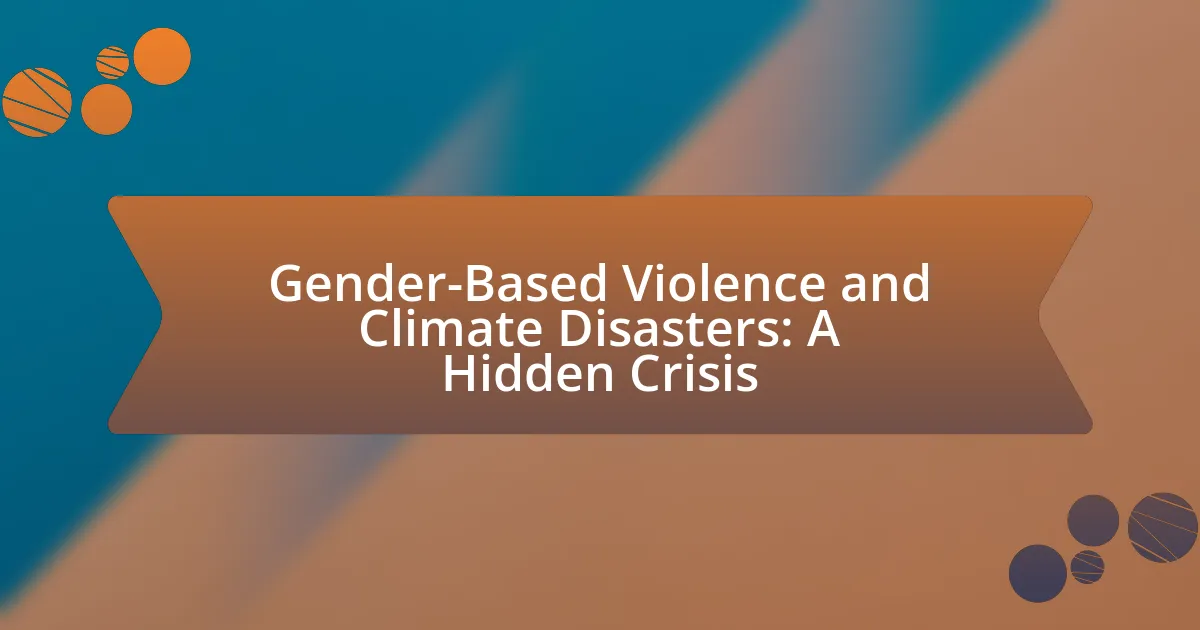Gender-Based Violence (GBV) in the context of climate disasters represents a significant and often overlooked crisis, where environmental crises such as floods and hurricanes exacerbate existing vulnerabilities, particularly for women and marginalized groups. The article explores the intersection of GBV and climate disasters, highlighting how displacement, economic stress, and the breakdown of social structures contribute to increased violence. It examines the underlying causes of this issue, the psychological effects on survivors, and the societal stigma that hinders reporting. Furthermore, it discusses necessary support systems and strategies for addressing this crisis, emphasizing the importance of community-based interventions and policy changes to mitigate the impacts of climate disasters on gender-based violence.

What is Gender-Based Violence and Climate Disasters: A Hidden Crisis?
Gender-Based Violence (GBV) in the context of climate disasters refers to the increased risk and prevalence of violence against individuals, particularly women and marginalized groups, during and after environmental crises. Climate disasters, such as floods, hurricanes, and droughts, exacerbate existing inequalities and vulnerabilities, leading to heightened instances of domestic violence, sexual assault, and exploitation. Research indicates that during such crises, the breakdown of social structures and increased stress can lead to a rise in GBV, as evidenced by reports from organizations like the United Nations, which highlight that women are disproportionately affected by both climate change and violence.
How do gender-based violence and climate disasters intersect?
Gender-based violence and climate disasters intersect through increased vulnerability and exposure of marginalized groups during and after such events. Climate disasters, such as hurricanes and floods, often lead to displacement, economic instability, and breakdown of social structures, which can exacerbate existing gender inequalities. For instance, a study by the United Nations Office for Disaster Risk Reduction found that women and girls are disproportionately affected by climate-related disasters, facing heightened risks of violence, exploitation, and abuse in the aftermath. Additionally, during crises, resources become scarce, leading to increased tensions and potential for violence within households and communities.
What are the underlying causes of gender-based violence in the context of climate disasters?
The underlying causes of gender-based violence in the context of climate disasters include increased economic stress, displacement, and the breakdown of social structures. Economic stress arises as climate disasters disrupt livelihoods, leading to heightened tensions within households and communities. Displacement from homes due to extreme weather events often leaves women and girls vulnerable to violence in temporary shelters or unsafe environments. Additionally, the breakdown of social structures during and after disasters can diminish protective community norms, increasing the risk of violence against women. Research by the United Nations highlights that women are disproportionately affected by climate change, which exacerbates existing inequalities and vulnerabilities, leading to higher rates of gender-based violence in disaster-affected areas.
How do climate disasters exacerbate existing gender inequalities?
Climate disasters exacerbate existing gender inequalities by disproportionately impacting women and marginalized groups, who often face increased risks of violence, economic instability, and limited access to resources. For instance, after natural disasters, women are more likely to experience gender-based violence due to the breakdown of social structures and increased stress on families. Additionally, women typically have less access to financial resources and decision-making power, which hinders their ability to recover and adapt to changing conditions. According to a report by the United Nations, women and girls are 14 times more likely than men to die during a disaster, highlighting the severe disparities in vulnerability and resilience.
Why is this issue often considered a hidden crisis?
Gender-based violence in the context of climate disasters is often considered a hidden crisis because it frequently goes unreported and is underrecognized in disaster response frameworks. Research indicates that during climate-related events, such as hurricanes or floods, the incidence of gender-based violence increases significantly, yet these incidents are often overshadowed by the immediate physical impacts of the disaster. For example, a study by the United Nations highlights that women and girls are disproportionately affected by violence in the aftermath of such events, but the lack of data collection and reporting mechanisms means that these issues remain largely invisible. This invisibility contributes to a cycle of neglect, where the needs of survivors are not adequately addressed in recovery efforts, further entrenching the crisis.
What factors contribute to the invisibility of gender-based violence during climate disasters?
The invisibility of gender-based violence during climate disasters is primarily due to societal stigma, lack of data, and inadequate response mechanisms. Societal stigma surrounding gender-based violence often leads to underreporting, as victims may fear judgment or disbelief. Additionally, the absence of comprehensive data collection during and after climate disasters obscures the true prevalence of such violence, making it difficult to address effectively. Furthermore, inadequate response mechanisms, including insufficient training for first responders and a lack of resources for support services, contribute to the ongoing neglect of this issue in disaster contexts. These factors collectively create an environment where gender-based violence remains hidden, despite its significant impact on affected populations.
How does societal stigma affect the reporting of gender-based violence in disaster situations?
Societal stigma significantly hinders the reporting of gender-based violence in disaster situations by instilling fear of judgment and shame among survivors. This stigma often leads victims to believe that they will not be believed or supported, which discourages them from coming forward. Research indicates that in post-disaster contexts, such as the aftermath of Hurricane Katrina, survivors faced increased vulnerability to violence but were less likely to report incidents due to societal perceptions that blame victims for their circumstances. Furthermore, studies show that cultural norms surrounding gender roles can exacerbate this issue, as victims may fear ostracization or retaliation from their communities. Thus, societal stigma creates a barrier that prevents accurate reporting and acknowledgment of gender-based violence in the wake of disasters.

What are the impacts of climate disasters on gender-based violence?
Climate disasters significantly increase the incidence of gender-based violence. Research indicates that during and after such disasters, women and marginalized groups face heightened risks of violence, including domestic abuse and sexual assault, due to factors like displacement, economic stress, and the breakdown of social structures. For instance, a study by the United Nations Population Fund found that in the aftermath of Hurricane Katrina, reports of domestic violence surged by 50%. Additionally, the World Health Organization highlights that natural disasters exacerbate existing inequalities, making women more vulnerable to exploitation and violence.
How do different types of climate disasters influence rates of gender-based violence?
Different types of climate disasters significantly increase rates of gender-based violence due to heightened vulnerability and social instability. For instance, natural disasters like hurricanes and floods often lead to displacement, which can exacerbate existing gender inequalities and create environments where violence against women is more likely to occur. Research indicates that after Hurricane Katrina, reports of domestic violence surged by 23% in affected areas, highlighting the correlation between disaster-induced stress and increased violence. Additionally, during droughts, economic strain can lead to increased tensions within households, further elevating the risk of gender-based violence. These patterns demonstrate that climate disasters not only disrupt communities but also intensify the conditions that foster violence against women.
What role does displacement play in increasing vulnerability to gender-based violence?
Displacement significantly increases vulnerability to gender-based violence by disrupting social structures and support systems. When individuals are forced to leave their homes due to climate disasters or conflict, they often find themselves in overcrowded and unsafe living conditions, such as refugee camps, where the risk of violence escalates. Research indicates that displaced women and girls face heightened threats from both intimate partners and strangers, as the breakdown of community norms and the lack of legal protections create an environment conducive to abuse. For instance, a study by the United Nations High Commissioner for Refugees (UNHCR) found that displaced women are at least 2.5 times more likely to experience sexual violence compared to their non-displaced counterparts. This evidence underscores the critical link between displacement and increased vulnerability to gender-based violence.
How do economic stressors from climate disasters affect domestic violence rates?
Economic stressors from climate disasters significantly increase domestic violence rates. Research indicates that financial strain, loss of housing, and unemployment resulting from climate-related events can exacerbate tensions within households, leading to higher instances of violence. For example, a study published in the journal “Nature Climate Change” found that economic hardships following natural disasters correlate with a 25% increase in domestic violence reports in affected areas. This relationship highlights how the stress of economic instability can trigger violent behavior, particularly in vulnerable populations.
What are the psychological effects of climate disasters on survivors of gender-based violence?
Survivors of gender-based violence experience heightened psychological effects following climate disasters, including increased anxiety, depression, and post-traumatic stress disorder (PTSD). The disruption caused by climate disasters exacerbates existing trauma from violence, leading to feelings of helplessness and isolation. Research indicates that survivors may also face challenges in accessing mental health services due to displacement and resource scarcity, further intensifying their psychological distress. A study published in the journal “Global Environmental Change” highlights that the intersection of climate change and gender-based violence creates a compounded risk for mental health issues, emphasizing the urgent need for targeted support for these vulnerable populations.
How does trauma from climate disasters compound the effects of gender-based violence?
Trauma from climate disasters exacerbates gender-based violence by increasing vulnerability and stress within affected communities. The destruction of homes and livelihoods often leads to economic instability, which can heighten tensions and result in increased violence against women. For instance, a study by the United Nations Population Fund indicates that during and after disasters, rates of intimate partner violence can rise significantly due to factors such as displacement, loss of social support, and heightened anxiety. Additionally, the breakdown of community structures and services during climate events can limit access to resources and support systems for survivors, further compounding their trauma and exposure to violence.
What support systems are necessary for survivors in the aftermath of disasters?
Survivors in the aftermath of disasters require comprehensive support systems that include psychological counseling, legal assistance, healthcare services, and community-based support networks. Psychological counseling is essential for addressing trauma and mental health issues, as studies show that disaster survivors often experience increased rates of anxiety and depression. Legal assistance helps survivors navigate issues related to domestic violence, property rights, and access to resources, which is crucial in the context of gender-based violence that can escalate during and after disasters. Healthcare services are vital for addressing both physical injuries and reproductive health needs, as evidenced by reports indicating that women are particularly vulnerable to health complications in disaster scenarios. Community-based support networks foster social cohesion and provide practical assistance, such as shelter and food, which are critical for recovery. These interconnected support systems are necessary to ensure the safety, health, and well-being of survivors, particularly in the context of gender-based violence exacerbated by climate disasters.

What strategies can be implemented to address this crisis?
To address the crisis of gender-based violence exacerbated by climate disasters, implementing comprehensive community-based intervention strategies is essential. These strategies should include establishing support networks that provide immediate assistance to survivors, such as shelters and counseling services, which have been shown to reduce the incidence of violence in vulnerable populations. Additionally, integrating gender-sensitive approaches into disaster response plans can ensure that the specific needs of women and marginalized groups are met, as evidenced by the United Nations’ findings that such integration leads to more effective recovery outcomes. Training local leaders and first responders on recognizing and addressing gender-based violence during and after climate events can further enhance community resilience and safety.
How can communities better prepare for the intersection of gender-based violence and climate disasters?
Communities can better prepare for the intersection of gender-based violence and climate disasters by implementing comprehensive risk assessments and developing targeted response strategies. These strategies should include training local leaders and first responders on the specific vulnerabilities faced by marginalized groups during climate events, as studies indicate that women and children are disproportionately affected by both climate change and violence. For instance, the United Nations reports that during disasters, the risk of gender-based violence increases significantly, highlighting the need for proactive measures. Additionally, establishing safe shelters and support services that are accessible during climate emergencies can mitigate the risks associated with gender-based violence.
What role do local organizations play in mitigating gender-based violence during disasters?
Local organizations play a crucial role in mitigating gender-based violence during disasters by providing immediate support services, raising awareness, and advocating for policy changes. These organizations often have established trust within communities, enabling them to effectively identify at-risk individuals and offer essential resources such as shelter, counseling, and legal assistance. For instance, during the 2010 Haiti earthquake, local women’s organizations were instrumental in addressing the surge of violence against women by implementing safety measures and providing support networks. Their localized knowledge and community engagement are vital for tailoring interventions that address specific cultural and social dynamics, ultimately reducing the incidence of gender-based violence in disaster-affected areas.
How can policy changes improve the response to gender-based violence in disaster scenarios?
Policy changes can significantly enhance the response to gender-based violence in disaster scenarios by establishing comprehensive frameworks that prioritize the safety and needs of vulnerable populations. For instance, integrating gender-sensitive approaches into disaster response plans ensures that resources are allocated effectively to support survivors, as evidenced by the United Nations’ guidelines which emphasize the importance of addressing gender-based violence in humanitarian settings. Furthermore, implementing training programs for first responders on recognizing and addressing gender-based violence can lead to more effective interventions, as shown in studies where trained personnel reported higher rates of survivor support and resource referrals. These policy changes create a structured environment that not only responds to immediate needs but also fosters long-term resilience against gender-based violence in the aftermath of disasters.
What best practices can be adopted to support survivors of gender-based violence in the wake of climate disasters?
To support survivors of gender-based violence in the wake of climate disasters, it is essential to implement trauma-informed care, establish safe shelters, and provide access to legal and psychological support. Trauma-informed care ensures that services are sensitive to the needs of survivors, recognizing the impact of trauma on their well-being. Safe shelters offer immediate protection and a secure environment for survivors, which is crucial during times of crisis when traditional support systems may be disrupted. Access to legal and psychological support empowers survivors to seek justice and healing, addressing both their emotional and legal needs. Research indicates that integrating these practices can significantly improve outcomes for survivors, as evidenced by programs in disaster-affected regions that have successfully reduced instances of violence and provided comprehensive support.
What resources are available for communities to educate themselves on this issue?
Communities can access various resources to educate themselves on gender-based violence and climate disasters. Key resources include reports from organizations like the United Nations, which provides comprehensive data and analysis on the intersection of climate change and gender-based violence. The World Health Organization also offers guidelines and research on the health impacts of climate-related disasters on vulnerable populations, including women. Additionally, local NGOs often conduct workshops and training sessions focused on these issues, providing practical knowledge and community engagement. Academic journals such as “Gender & Development” publish peer-reviewed articles that explore the relationship between climate change and gender-based violence, offering evidence-based insights. These resources collectively empower communities to understand and address the hidden crisis of gender-based violence exacerbated by climate disasters.
How can individuals contribute to raising awareness about gender-based violence and climate disasters?
Individuals can contribute to raising awareness about gender-based violence and climate disasters by engaging in community education and advocacy efforts. For instance, they can participate in local workshops or seminars that focus on the intersection of gender issues and environmental challenges, thereby informing others about how climate change exacerbates gender-based violence. Research indicates that women and marginalized groups are disproportionately affected by climate disasters, with a UN report highlighting that natural disasters can lead to increased rates of domestic violence and exploitation. By sharing this information through social media campaigns or community events, individuals can amplify the message and encourage collective action against these intertwined crises.
